Sample Standards, Guidelines, and Tips for your Community!
Basic Information and Questions
Dining platforms and parklets are activated spaces for people that are installed where parking was once permitted. For the duration of all COVID-19 related emergency orders issued by the State of Michigan, cities and other communities may consider permitting dining platforms or parklets to occupy public parking spaces or off-street parking lots. Approval can be valid through the fall or for extended seasonal use every year, depending on the community’s preference. The purpose of permitting these platforms is to aid local establishments during the period when full occupancy of a restaurant’s indoor space is not permitted. They can also be used to establish outdoor gathering places when limited sidewalk space is available. Transforming parking spaces to parklets and dining platforms shifts the focus from cars to people.
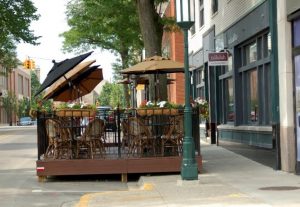

What is a dining platform?
A dining platform is a structure designed to provide outdoor space for restaurant seating.
What is a parklet?
It’s similar to a dining platform but may be used for other small gatherings beyond dining. It may contain seating, waste receptacles, and seasonal plants. Parklets are great opportunities to add more “people space” to a street to create a sense of vibrancy and activity.
Can there be a dining area on the sidewalk and a dining platform in a parking space?
Yes. Local establishments may utilize sidewalk dining that is in accordance with the existing outdoor patio standards in addition to dining platforms in a parking space if the right-of-way is locally owned. Otherwise permits will be required from the applicable road agency.
Where can an outdoor dining platform or parklet be established?
Public parking or public on-street parking areas are the most common locations. The community can grant approval to dining platforms in public parking spaces within designated districts. If an establishment wishes to use more than one on-street parking space and one of these is not directly in front of the establishment, the consent of the owner of the property with frontage on the space is typically required. On private property, an establishment may apply for the use of one or two parking spaces as outdoor dining space for the stated period, provided that the property owner, if different from the applicant, supports the application.
Can alcohol be served on a dining platform?
Establishments must apply to the Michigan Liquor Control Commission for permission to serve alcohol on the dining platform and furnish proof of said permission to the community.
Platform Design
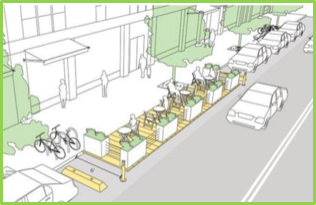
Sample Dimensional Requirements
- Dining platforms or parklets shall not be larger than 8 ft wide by 20 ft long. A second 20 ft-long platform may be permitted.
- The dining platform shall be located a minimum of 2 feet from the adjacent travel lane.
- A dining platform in an off-street parking space shall maintain six inches of distance between the edge of the platform and the lines marking the parking space. A dining platform or parklet shall also maintain one foot of unoccupied space at the end of the space closest to the maneuvering lane.
- A dining platform or parklet shall not be closer than 25 feet to a street intersection or driveway.
Parklet Design Guide from NACTO
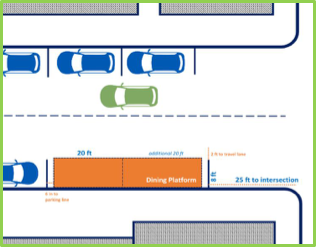
- Parklets should have a 4 ft. buffer from active parking spots using a wheel stop.
- Parklets should incorporate vertical elements to make them visible to traffic.
- The minimum width of a parklet should be 6 ft. Ideally, parklets occupy one or more parallel spots or 3-4 angled parking spots.
- Parklets should have a flush transition to the sidewalk to avoid tripping hazards.
- Seating should be incorporated into the design of the parklet.
- The sub-structure of the parklet should provide a level surface. “Bison pedestals” can be useful for sloping streets.
- Parklets should use slip-resistant surfaces to minimize hazards.
Sample Design Guidelines
The style of the dining platform or parklet may or may not be regulated. However, in the interest of maintaining an atmosphere of high-quality design in your community and promoting the comfort of visitors, the following design guidelines are suggested for all dining platforms or parklets:
- Materials used to construct a dining platform should be high quality and durable.
- Green features, such as planter boxes and potted plants, are strongly encouraged. On busy streets especially, planters on top of the safety fence will help to mitigate traffic noise and exhaust.
- Consider overhead cover, such as umbrellas or an open-sided canopy.
- Matching furniture is encouraged to achieve a coherent appearance.
- The incorporation of public art is strongly encouraged.
- The incorporation of bicycle parking is encouraged.
- The use of very dark materials for the surface of the platform is discouraged, as this contributes to a heat island effect.
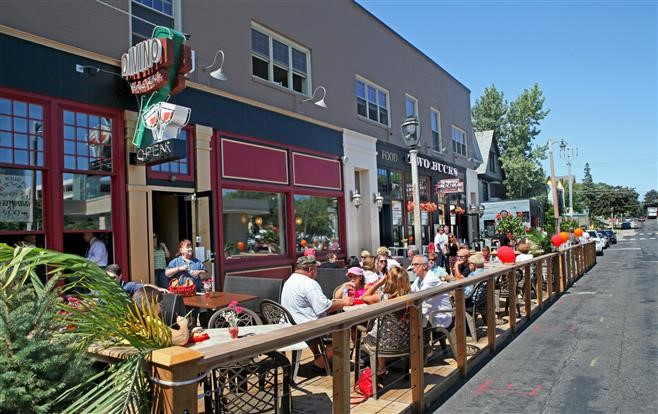
Recommended Minimum Design Requirements
- The area of the platform shall have a ground cover. The manner of cover is encouraged to be a deck with an elevation flush with the adjacent sidewalk. The gap between the deck and the sidewalk curb should not exceed one half-inch.
- The dining platform or parklet shall be surrounded on all sides bordering either a street or a parking space not occupied by a dining platform with a fence or other barrier a minimum of 36 inches and a maximum of 42 inches tall, as measured from the deck of the platform, or from grade where a platform is not elevated. In an off-street parking lot, the fence shall not be closer than 6 inches to the line marking the parking space. In an on-street parking area, the fence or barrier shall not project greater than three inches toward the street from the edge of the platform.
- The spacing of seating shall be in accordance with the state distancing orders in place at the time; the spacing of seating may be changed in accordance with new distancing orders, as they are issued by the state.
- Street drainage shall be maintained.
- The corners of the fencing shall be fitted with reflectors.
- Platforms shall not interfere with utility access, bus zones, or curbside drainage. Every platform shall meet construction standards of both the city’s Building Code and the Americans with Disabilities Act Accessibility Guidelines.
- All platforms shall be located at least one parking space away from an intersection or street corner or shall be protected by a curb-extension (bulb-out) or some other physical barrier.
- All additional appurtenances, such as planters, landscape materials, umbrellas and the like shall be contained within the confines of the platform.
Elements to Consider for your Dining Platform or Parklet
- Buffers from traffic
- Decking material
- Tables
- Physical Distancing
- Seating
- Shade
- Vegetation and landscaping
- Amenities: Hand sanitizer stations, bike parking, trash, lighting, sound
- Public restrooms
- Liability insurance
- Input from local attorney, planner, and traffic engineer
Process for establishing a Dining Platform or Parklet in your Community
Similar to establishing an outdoor space for dining on a public sidewalk, your community can require an establishment to apply for permission to construct a dining platform or parklet using an “Application for Outdoor/Sidewalk Cafes or Display Area Approval” and pay a review fee. Some are waiving fees during COVID-19 restrictions. The application may include:
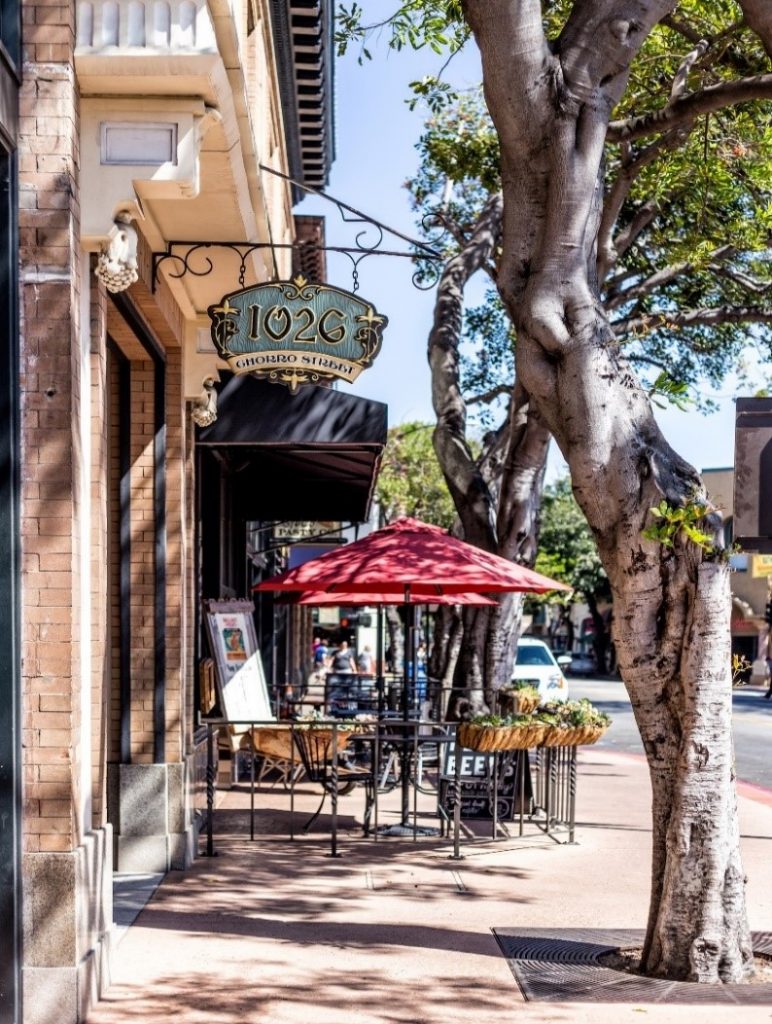
- Fully dimensioned illustrations showing the proposed platform and identifying the parking space or spaces to be used. Required dimensions include:
- the height of the platform
- height of railings
- number of tables and seats to be accommodated and their distance from each other
- the height of any appurtenances such as heat lamps or umbrellas
- the slope and sidewalk encroachment of any ramp leading to the platform
- the length and width of the platform
- the length and width of the parking space
- An illustration identifying the parking space or spaces to be occupied by the platform. Aerial images are acceptable.
- If the use of a parking space on private property is requested, the signature of the property owner, if different from the applicant.
- Where the parking space requested for use is in a parking lot adjacent to a residential property, the distance from the proposed platform to the nearest residential property line.
- The proposed hours of operation of the platform.
- A brief description of the operations proposed on the platform.
- Proof of General Commercial Liability Insurance extending to operation of the platform. The city shall be named on such liability policies as “Additional Named Insured”.
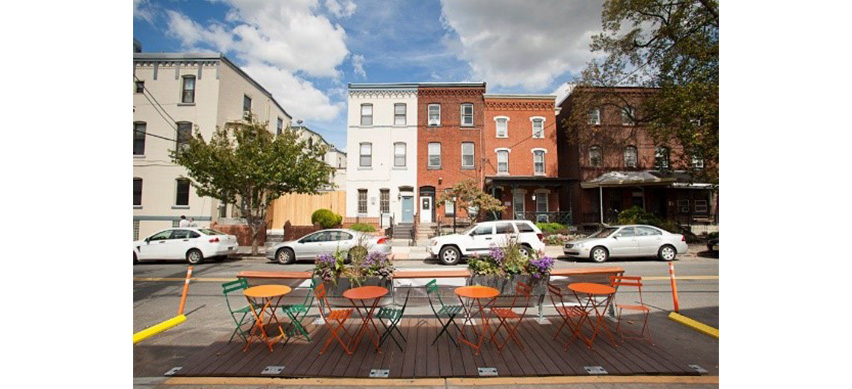 University City, PA
University City, PA
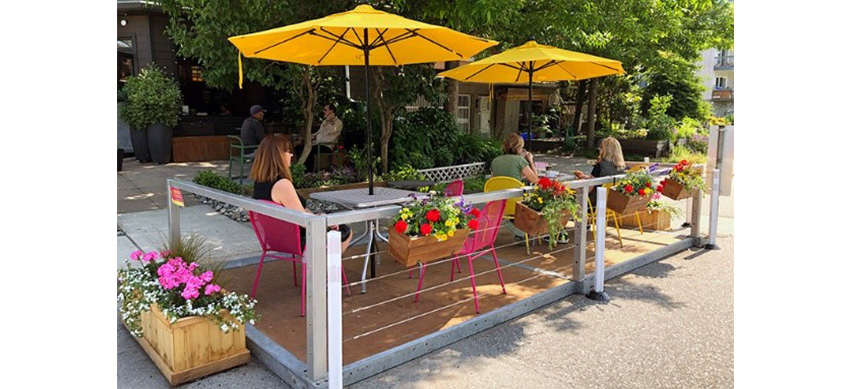 Vancouver, Canada
Vancouver, Canada
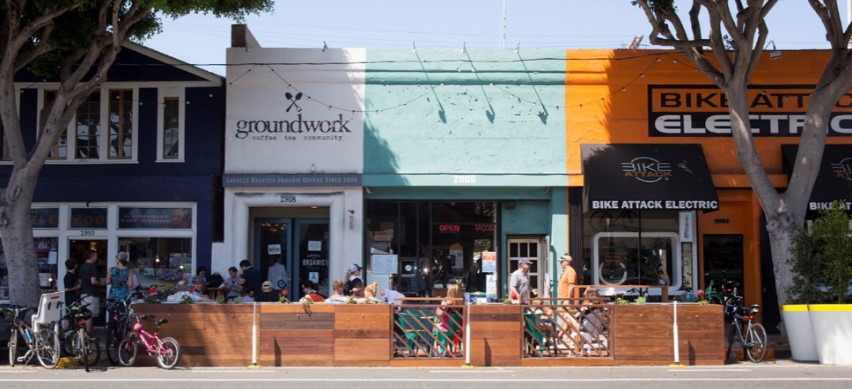 Santa Monica, CA
Santa Monica, CA



